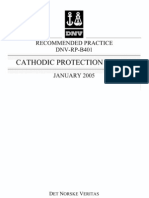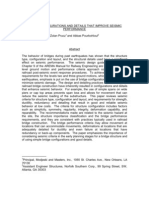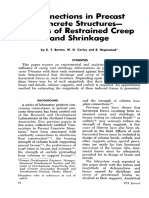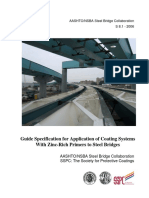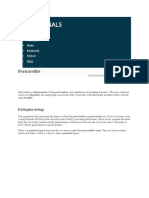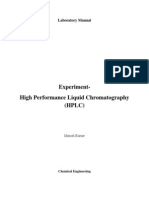Bridge Design For Vessel Colission
Bridge Design For Vessel Colission
Uploaded by
ASHISACopyright:
Available Formats
Bridge Design For Vessel Colission
Bridge Design For Vessel Colission
Uploaded by
ASHISAOriginal Description:
Original Title
Copyright
Available Formats
Share this document
Did you find this document useful?
Is this content inappropriate?
Copyright:
Available Formats
Bridge Design For Vessel Colission
Bridge Design For Vessel Colission
Uploaded by
ASHISACopyright:
Available Formats
SHIP & BARGE COLLISIONS
WITH BRIDGES
General Overview
AASHTO Code
Michael Knott, P.E.
Dr. Eric Nichol, P.E.
Western Bridge Engineers’ Seminar
Mikele Winters, P.E. September 4-6,2013
Bellevue, WA
Background
Major Bridge Collapses in the U.S.
Bridge Location Year Fatalities
• Accidents do happen …
Lake Ponchartrain, LA 1964 6
Chesapeake Bay Bridge, VA 1970 0
– It’s Only A Matter of Time (Risk)
Sidney Lanier Bridge, GA 1972 10
Chesapeake Bay Bridge, VA 1972 0
– Knott’s Rule: If You Build It … Lake Ponchartrain Bridge, LA 1974 3
They Will Hit It
Pass Manchac Bridge, LA 1976 1
Benjamin Harrison Bridge, VA 1977 0
• 36 Major Collapses since 1960
Union Avenue Bridge, NJ 1977 0
Berwick Railroad Bridge, LA 1978 0
Due to Vessel Collisions Sunshine Skyway Bridge, FL 1980 35
– 18 Collapses in the U.S. Hannibal Railroad Bridge, MI
Lake Ponchartrain Bridge, LA
1982
1984
0
0
– 340+ Fatalities Bonner Bridge, NC 1990 0
Judge Seeber Bridge, LA 1993 1
• 250+ Minor Vessel Bayou Canot RR Bridge, AL
Queen Isabella Bridge, TX
1993
2001
47
8
Collisions/Year I-40 Bridge over Ark. River, OK 2002 13
Popps Ferry Bridge, MS 2009 0
Eggner Ferry Bridge, KY 2012 0
Vessel Collision Design of Highway Bridges
Background
• People do die … Really!
– If it happened to you ….
You wouldn’t like it either
Vessel Collision Design of Highway Bridges
Background
• Oil spills from accidents do occur
… Really!
Barge Collision with Swing Bridge Fender System Ship Collision with San Francisco – Oakland
Bay Bridge Main Pier Fender System
Vessel Collision Design of Highway Bridges
Background
• Modern Vessels
Are Longer
& Wider Than In
The Past
1940’s – 1960’s
1970’s – Present
Vessel Collision Design of Highway Bridges
Background
• Many older
“Long Span”
bridges …
aren’t long
enough for
today’s larger
vessels
Vessel Collision Design of Highway Bridges
Background
• Many bridge openings are too narrow
for today’s larger/wider ships and barge tows
Vessel Collision Design of Highway Bridges
Background
• Bridges are
often located
near congested
marine terminal
facilities
Vessel Collision Design of Highway Bridges
Background
• Too many
bridges over
navigable
waterways
in some
locations
Vessel Collision Design of Highway Bridges
Background
• Frequency of
ship & barge
traffic has
increased in
many harbors
and channels
Vessel Collision Design of Highway Bridges
Background
• Vessels Get In Trouble Due to …
PILOT ERROR
• Some Causes ...
– Inattentiveness
– Drunkenness/Tiredness
– Crew Misunderstandings
– Poor Judgment
– Violate Navigation Rules
– Incorrect Evaluation
of Wind/Current Conditions
Vessel Collision Design of Highway Bridges
Background
• Vessels Get In Trouble Due to …
MECHANICAL FAILURE
• Some Causes ...
– Engine Failure
– Steering Failure
– Other Mechanical &
Electrical Equipment
Failures
Vessel Collision Design of Highway Bridges
Background
• Vessels Get In Trouble Due to …
ADVERSE ENVIRONMENTAL
CONDITIONS
• Some Causes ...
– Poor Visibility (Rainstorm, Fog)
– High Density of Ship
& Barge Traffic
– Strong Currents
– Wind Squalls
– Poor Navigation Aids
– Awkward Channel Alignments
Vessel Collision Design of Highway Bridges
Sunshine Skyway Bridge
Tampa Bay, FL (1980)
Vessel Collision Design of Highway Bridges
Tjörn Bridge
Almo Sound, Sweden (1980)
Vessel Collision Design of Highway Bridges
Ulyanovsk Railway Bridge
Volga River, Russia (1983)
177 Fatalities when top deck of
cruise ship was “decapitated”
Tasman Bridge
Derwent River, Hobart, Australia (1975)
Vessel Collision Design of Highway Bridges
Benjamin Harrison Bridge
James River, Hopewell, VA (1977)
Vessel Collision Design of Highway Bridges
Sidney Lanier Bridge
Brunswick, GA (1983)
Vessel Collision Design of Highway Bridges
Bonner Bridge
Oregon Inlet, NC (1990)
Vessel Collision Design of Highway Bridges
Claiborne Ave. Bridge
New Orleans, LA (1993)
Vessel Collision Design of Highway Bridges
Bayou Canot RR Bridge
Mobile, AL (1993)
Vessel Collision Design of Highway Bridges
Million Dollar Bridge
Portland, Maine (1996)
• Tanker Ship Accident
(LOA=560’, Width=85’)
• Double Leaf Bascule Bridge
(Horizontal Navigation
Clearance = 95’)
• 170,000 Gallons of Fuel Oil
Spilled
Vessel Collision Design of Highway Bridges
Queen Isabella Bridge
South Padre Island, TX (2001)
Vessel Collision Design of Highway Bridges
I-40 Bridge over Arkansas River
Webber Falls, OK (2002)
Vessel Collision Design of Highway Bridges
Popps Ferry Bridge
Biloxi, Miss (March 2009)
"There's 35,000 cars a day that
goes across this bridge," A.J.
Holloway said. "How there wasn't a
car on there, or a vehicle, or a
school bus at that time (7:20 AM),
on that span, is just amazing to
me."
Vessel Collision Design of Highway Bridges
Eggner Ferry Bridge
Marshall, KY (January 2012)
Vessel Collision Design of Highway Bridges
Movable Bridges
• Get hit fairly often
… (like magnets
to vessels)
Vessel Collision Design of Highway Bridges
Mast Collisions
• Occur frequently – but are
usually not catastrophic
Vessel Collision Design of Highway Bridges
Legal Things You Should Know …
• Bridges Are Obstructions
to Marine Navigation
• Mariners Have the
Right of Way … Not Motorists
• Bridges Must Provide for the Reasonable
Needs of Navigation
• Bridges are Permitted to be Built as
Obstructions to Navigation by the USCG
• Bridges Must be Maintained in
Accordance with USCG Permits
Vessel Collision Design of Highway Bridges
Collision Code Purpose
• “In navigable waterway areas, where vessel collision by merchant
ships and barges may be anticipated, bridge structures shall be
designed to prevent collapse of the superstructure by considering the
size and type of the vessel, available water depth, vessel speed, and
structure response.”
– Significant damage, even failure, of secondary members is permitted as long
as redundant load paths exist and the superstructure does not collapse
• “Bridges over a navigable waterway meeting the guide specification
criteria, whether existing or under design, should be evaluated as to
its vulnerability to vessel collision in order to determine prudent
measures to be taken for its protection.”
Vessel Collision Design of Highway Bridges
Pensacola Bay Bridge
Florida (1989)
Bridge Superstructure Survived
Due To Structural Redundancy
Vessel Collision Design of Highway Bridges
Ship Collision Force on Pier
• Woisin’s
large-scale
dynamic
model tests
Vessel Collision Design of Highway Bridges
Ship Collision Force on Pier
• Typical impact data from Woisin
(0.1 - 0.2 sec)
(3 - 4 sec)
Average Impact Force vs. Time (t) Average Impact Force vs. Bow Crushing Length (a)
Vessel Collision Design of Highway Bridges
Ship Collision Force on Pier
• Guide Commentary
contains discussion of
differences
in ship collision forces
between AASHTO,
German, Asian, and
Danish research
0.0 0.5 1.0 1.5 2.0 2.5 3.0 3.5
Comparison of ship impact forces for 50,000 DWT Bulk
Carrier (Tongji Univ., Shanghai, China)
Vessel Collision Design of Highway Bridges
Barge Collision Force on Pier
• Full scale barge impact testing by
Florida DOT used by the
University of Florida (2006) to
develop and calibrate a FEM
barge collision numerical model
– St. George Bridge across
Apalachicola Bay
Vessel Collision Design of Highway Bridges
Location of Impact Forces
• Examples of vessel bow overhang impact
Sunshine Skyway Bridge Collapse
Vessel Collision Design of Highway Bridges
Location of Impact Forces
• Example of ship bow overhang
Container Pier Accident
Vessel Collision Design of Highway Bridges
Location of Impact Forces
• Local Bow Crushing During Impact
Vessel Collision Design of Highway Bridges
Location of Impact Forces
• Local Bow Crushing During Impact
Container Pier Accident
Vessel Collision Design of Highway Bridges
Bridge Analysis Options
• AASHTO provides three alternative analysis methods for determining
the design vessel for each bridge component in the structure in
accordance with a two-tiered risk acceptance criteria.
– Method I is a simple to use semi-deterministic procedure
• Limited to Barges in Shallow Draft Waterways
– Method II is a detailed risk analysis procedure
• Required for Ships in Deep Draft Waterways
– Method III is a cost-effectiveness of risk reduction procedure
• Based on a classical benefit/cost analysis
• Risk Acceptance Criteria
– Critical Bridges: Risk of Collapse 1 in 10,000 years
– Typical Bridges: Risk of Collapse 1 in 1,000 years
Vessel Collision Design of Highway Bridges
Overview of Risk Analysis Procedure
WATERWAY CHARACTERISTICS
• Channel Geometry
• Water Depths
• Water Currents RISK ANALYSIS (Methods I, II or III)
• Navigation Aids • Risk of Collision/Collapse
• History of Previous Vessel Accidents • Collision Impact Loads
• Protection Alternatives
• Cost-Effectiveness
FLEET CHARACTERISTICS
• Vessel Types & Sizes
• Loading Conditions (Ballasted/Loaded)
• Transit Speeds & Paths No
MEETS ACCEPTANCE CRITERIA ?
• Number of Annual Passages
• Risk (Annual Frequency of Collapse)
• Cost (Within Project Budget Constraints)
REVISE BRIDGE, FLEET or
BRIDGE & SITE CHARACTERISTICS WATERWAY CHARACTERISTICS
• Bridge Type, Size & Location
Yes
• Span Lengths
• Pier Geometry LEAST COST PROTECTION SYSTEM?
• Impact Resistance No
• Geotechnical Data Yes
• H&H/Scour Data
• Environmental Constraints FINALIZE PROTECTION & FENDER
REPAIR/REPLACEMENT PLANS
Vessel Collision Design of Highway Bridges
Annual Frequency of Collapse
• The annual frequency of bridge element collapse
shall be computed by:
– where,
AF = Annual frequency of bridge element collapse due to
vessel collision
N = Annual number of vessels classified by type, size, and
loading condition which can strike the bridge element
PA = Probability of vessel aberrancy
PG = Geometric probability of a collision between an
aberrant vessel and a bridge pier or span
PC = Probability of bridge collapse due to a collision
with an aberrant vessel
PF = Adjustment factor to account for potential protection of
the piers from vessel collision due to upstream or down
stream land masses, or other structures, that block
the vessel from hitting the pier.
Vessel Collision Design of Highway Bridges
Annual Frequency of Collapse
Downbound Vessels
• Relatively straightforward Vessel
Upbound
N
Type Vessels
PA PG PC PF Growth
Factor
AF
analysis using programs like Vessel
Type
……. N …PA …PG …PC …PF …Growth …. AF
Factor
….
Excel or MathCAD to automate
……. … … … … … …. ….
……. … … … … … …. ….
……. … … … … … …. ….
……. … … … … … …. ….
the repetitive analysis process ……. … … … …
Total AF All Vessels
… ….
Total AF All Vessels
….
….
….
– Setup for Each Specific Project Pier 1
+ (PLUS)
• Total bridge AF is the sum of the Downbound Vessels
individual component AF’s (piers Vessel
Upbound
N
Type Vessels
PA PG PC PF Growth
Factor
AF
exposed to collision) Vessel
Type
……. N
…….
…PA
…
…PG
…
…PC
…
…PF
…
…Growth …. AF
…
Factor
….
….
….
……. … … … … … …. ….
……. … … … … … …. ….
……. … … … … … …. ….
Total AF All Vessels ….
……. … … … … … …. ….
Total AF All Vessels ….
Pier 2
+ (PLUS)
Pier 3 + Pier 4 + Pier 5 … etc. = Sum of All Pier AF’s
Vessel Collision Design of Highway Bridges
Annual Frequency of Collapse
• Once the input data has been developed and the risk
analysis tables have been generated, the program can be
used several ways:
– If the ultimate resistance strength of the piers has been computed
(ex. an existing bridge), you can solve for AF and determine if it
meets the risk acceptance criteria
– You can back-solve the ultimate pier strength needed for each
pier (ex. a new bridge) by setting the AF for each pier to the risk
acceptance criteria
– The strength of setting up the analysis in this manner is the ability
to ask “what if …” questions
• Different pier locations, span lengths, etc.
Vessel Collision Design of Highway Bridges
Bridge Protection Alternatives
• AASHTO Code
– Substructure Provisions
– Concrete & Steel Design
– Physical Protection Systems
• Fenders
• Pile supported systems
• Dolphins
• Islands
• Floating structures
– Movable Bridges
– Motorist Warning Systems
– Aids-to-Navigation
Vessel Collision Design of Highway Bridges
Bridge Protection Examples
• Design Bridge for Full Impact Force
• Fender Systems
• Pile-Supported Structures
• Protection Islands
Vessel Collision Design of Highway Bridges
Newport Bridge
Crossing Narragansett Bay, Rhode Island (1981)
• 31,800 DWT tanker hits main tower of suspension bridge at
approximately 6 knots
• Minor damage to bridge pier
• Vessel bow crushed in 11 feet
Vessel Collision Design of Highway Bridges
Luling Bridge
New Orleans, Louisiana
• Piers designed to withstand vessel impact forces (50,000 kips)
Vessel Collision Design of Highway Bridges
Throgs Neck Bridge
Crossing the East River, New York City
– Steel Framed
Fender System
80,000 DWT Ship
Vessel Collision Design of Highway Bridges
San Francisco / Oakland Bay Bridge
Fender / Footing Accident (2007)
Vessel Collision Design of Highway Bridges
East Bay Bridge
San Francisco – Oakland, California
• Concrete fenders used around perimeter of piers
– Piers also designed to withstand barge impact forces
Vessel Collision Design of Highway Bridges
Tappan Zee Bridge over Hudson River
Tarrytown, New York
Vessel Collision Design of Highway Bridges
Rosario - Victoria Bridge
Crossing the Paraná River, Argentina
– Pile Supported Structure System
Vessel Collision Design of Highway Bridges
Orinoco River Bridge
Venezuela
– Pile Supported Structure System
Vessel Collision Design of Highway Bridges
Sunshine Skyway Bridge
Tampa Bay, Florida
Vessel Collision Design of Highway Bridges
Sunshine Skyway Bridge
Tampa Bay, Florida
Vessel Collision Design of Highway Bridges
Dames Point Bridge
Jacksonville, Florida
Vessel Collision Design of Highway Bridges
Sunshine Skyway Bridge
Tampa Bay, Florida
Vessel Collision Design of Highway Bridges
Sunshine Skyway Bridge
Tampa Bay, Florida
Vessel Collision Design of Highway Bridges
Sunshine Skyway Bridge
Tampa Bay, Florida
Vessel Collision Design of Highway Bridges
Sunshine Skyway Bridge
Tampa Bay, Florida
Vessel Collision Design of Highway Bridges
Houston Ship Channel Bridge
Baytown, Texas
Vessel Collision Design of Highway Bridges
Dames Point Bridge
Jacksonville, Florida
Vessel Collision Design of Highway Bridges
Arthur Ravenel Jr. Bridge
Crossing the Cooper River, Charleston, SC
Vessel Collision Design of Highway Bridges
Sidney Lanier Bridge
Crossing the Brunswick River, Brunswick, GA
Vessel Collision Design of Highway Bridges
Orwell River Bridge
Ipswich, Suffolk, England
Vessel Collision Design of Highway Bridges
Vessel Collision Summary
• Let’s Learn From The Past
• Bridges Over Navigable
Waterways Need:
– Better Planning
– Longer Spans
– Stronger Piers
– Better Protection
– Better ATN
• Vessel Collision Requirements are now Mandatory under LRFD
Bridge Design Code
• Engineering Judgment and Specialized Skills are Required to Design
Pier Protection Systems
– Plastic / Non-Elastic / Sacrificial Structures
Vessel Collision Design of Highway Bridges
Final Thoughts
• Extreme Events will Usually Control
the Design of Most Major Bridges
– Vessel Collision
– Earthquakes
– Storm Surge & Waves
(Post Hurricane Katrina / Sandy Damage)
– Scour from Extreme Flood Events
• Terrorist Attacks (Post 9/11 World)
– Hijacked Vessel Used as a Weapon
Against Landmark Bridges
& Critical Transportation Links
– Confidential Studies Conducted by DOT’s
• Design of New Bridges for One Extreme
Event Usually Improves the Performance
Response to Other Extreme Events
Vessel Collision Design of Highway Bridges
THANK YOU FOR PARTICIPATING!
Vessel Collision Design of Highway Bridges
Western Bridge Engineers’ Seminar
September 4-6,2013
Bellevue, WA
You might also like
- (SED 4) Ship Collision With BridgesDocument132 pages(SED 4) Ship Collision With BridgesMarcela FigueiredoNo ratings yet
- The 4th International Cable Supported Bridge Operators' ConferenceDocument183 pagesThe 4th International Cable Supported Bridge Operators' Conferencem8r0ocvbs7100% (1)
- Company Vehicle PolicyDocument9 pagesCompany Vehicle Policysofia100% (3)
- BAPI Filling The Configuration StructuresDocument3 pagesBAPI Filling The Configuration StructuresBora GürNo ratings yet
- Cable Stayed Bridges Non Linear EffectsDocument69 pagesCable Stayed Bridges Non Linear EffectsManuel Alejandro C100% (1)
- 9 Sacrificial - Shuttering-1 by RMDocument18 pages9 Sacrificial - Shuttering-1 by RMASHISANo ratings yet
- DNV RP B401 2005Document28 pagesDNV RP B401 2005Faith OsegiNo ratings yet
- Bridge Design For Marine Vessel CollisionDocument87 pagesBridge Design For Marine Vessel CollisionJoe Halohali100% (1)
- Bridge Protective Ship CollisionDocument200 pagesBridge Protective Ship CollisionJuniorJavier Olivo FarreraNo ratings yet
- Stability of Arch BridgesDocument9 pagesStability of Arch BridgesJohnnie StrydomNo ratings yet
- TrussDocument121 pagesTrussHamza Ahmed MirNo ratings yet
- In Plane Arch Buckling of Network Arch BridgesDocument10 pagesIn Plane Arch Buckling of Network Arch BridgesAlin SalageanNo ratings yet
- Bridge Configurations and Details That Improve SeismicDocument20 pagesBridge Configurations and Details That Improve SeismicAlly KhooNo ratings yet
- Earthquake Design of Rectangular UndergroundDocument8 pagesEarthquake Design of Rectangular UndergroundtrabajosicNo ratings yet
- 2011 Bridge SarkadyDocument17 pages2011 Bridge SarkadyTan Duy LeNo ratings yet
- FR - 680 For LTRC 23-1ST MASH TL-4 Engineering Analyses and Detailing of 36-Inch and 42-Inch High Median Barriers For LADOTDDocument184 pagesFR - 680 For LTRC 23-1ST MASH TL-4 Engineering Analyses and Detailing of 36-Inch and 42-Inch High Median Barriers For LADOTDwalaywanNo ratings yet
- Brige Lauching Cap 1 PDFDocument16 pagesBrige Lauching Cap 1 PDFAnonymous VkzquW39No ratings yet
- By, Akshata A MulgundDocument153 pagesBy, Akshata A MulgundSaurav AdhikariNo ratings yet
- SR522 Seismic Isolation Bearings Report C8128Document27 pagesSR522 Seismic Isolation Bearings Report C8128Anonymous v613RZYANo ratings yet
- Marco RosignoliDocument8 pagesMarco RosignoliEd MateiNo ratings yet
- Vhi 4 HK 3 HDGFDocument9 pagesVhi 4 HK 3 HDGFDanielRoblesTorresNo ratings yet
- Pile Foundation For River BridgesDocument27 pagesPile Foundation For River BridgeskaushikrejaNo ratings yet
- Hybrid Solution To Cross Bosphorus StraitDocument205 pagesHybrid Solution To Cross Bosphorus StraitVan Cuong PhamNo ratings yet
- Allowable Tensile Stress For Webs of Prestressed Segmental Concrete BridgesDocument8 pagesAllowable Tensile Stress For Webs of Prestressed Segmental Concrete BridgesShikhar SinghNo ratings yet
- State-of-the-Art of Integral Abutment Bridges: Design and PracticeDocument10 pagesState-of-the-Art of Integral Abutment Bridges: Design and PracticeEduardo Reyes NegreteNo ratings yet
- Us 0754a Memoar GBDocument285 pagesUs 0754a Memoar GBAiman AmirNo ratings yet
- Modeling of Bridge Foundations-Lam Martin Imbsen PDFDocument14 pagesModeling of Bridge Foundations-Lam Martin Imbsen PDFAnonymous I8dXeoNo ratings yet
- Prec 38Document6 pagesPrec 38منصوري شيوخيNo ratings yet
- Bridge Deck BehaviourDocument327 pagesBridge Deck BehaviourJunwhan KimNo ratings yet
- Connections in Precast Concrete Structures - Effects of Restrained Creep and ShrinkageDocument20 pagesConnections in Precast Concrete Structures - Effects of Restrained Creep and Shrinkageunix0123No ratings yet
- AP-R617-20 Bridge Assessment Beyond The AS5100 Deterministic Methodology PDFDocument306 pagesAP-R617-20 Bridge Assessment Beyond The AS5100 Deterministic Methodology PDFRolex11No ratings yet
- Corrosion Evaluation and Tensile Results of Selected Post-Tensioning Strands at The SFOBB Skyway Seismic Replacement Project Report Phase 3 PDFDocument132 pagesCorrosion Evaluation and Tensile Results of Selected Post-Tensioning Strands at The SFOBB Skyway Seismic Replacement Project Report Phase 3 PDFgulilero_yoNo ratings yet
- JL-03-November-December The Strutted Box Widening Method For Prestressed Concrete Segmental BridgesDocument18 pagesJL-03-November-December The Strutted Box Widening Method For Prestressed Concrete Segmental BridgesVivek PremjiNo ratings yet
- Means and Methods Analysis of A Cast in Place Balanced Cantilever Segmental BridgeDocument302 pagesMeans and Methods Analysis of A Cast in Place Balanced Cantilever Segmental BridgeEnocHernandez0% (1)
- Nhi 16016Document310 pagesNhi 16016albertoxinaNo ratings yet
- Texas Bridge Railing ManualDocument79 pagesTexas Bridge Railing ManualBárbara CastroNo ratings yet
- The Grillage Analogy in Bridge Analysis: Can. J - Civ. Eng.. 9, 224-235Document12 pagesThe Grillage Analogy in Bridge Analysis: Can. J - Civ. Eng.. 9, 224-235KashiPrakash DambalNo ratings yet
- Assessment of Internal and External Prestressing of Prestressed Box GirdersDocument12 pagesAssessment of Internal and External Prestressing of Prestressed Box GirdersAbdi Septia PutraNo ratings yet
- Webinar FX Supartono Aerodynamic 2021-06-03Document136 pagesWebinar FX Supartono Aerodynamic 2021-06-03FX SupartonoNo ratings yet
- DSI-DYWIDAG Prestressing Systems Using Bars 02Document16 pagesDSI-DYWIDAG Prestressing Systems Using Bars 02Patrick Polujan100% (1)
- US 0925A Laminated Elastomeric Bearings AaefDocument78 pagesUS 0925A Laminated Elastomeric Bearings AaefspattiwarNo ratings yet
- Arch BridgeDocument133 pagesArch BridgeLau Kim Hwa100% (2)
- Arched BridgesDocument13 pagesArched BridgesRikesh SapkotaNo ratings yet
- Deflection Theory Analysis of Different Cable Profiles For Suspension BridgesDocument11 pagesDeflection Theory Analysis of Different Cable Profiles For Suspension BridgesRajat GuptaNo ratings yet
- SB6.1 Guideline STR PDFDocument137 pagesSB6.1 Guideline STR PDFBianca ZahariaNo ratings yet
- Web 5133Document118 pagesWeb 5133bbblguNo ratings yet
- Box Girder Bridges-MOD - 8Document34 pagesBox Girder Bridges-MOD - 8mohamed ahmedNo ratings yet
- Aashto Nsba s8.1Document28 pagesAashto Nsba s8.1Damen JohnsonNo ratings yet
- NZTA 2019359 Ahaura Bridge Replacement Contract Documents PDFDocument347 pagesNZTA 2019359 Ahaura Bridge Replacement Contract Documents PDFsab_veer2913No ratings yet
- Firth and CCANZ Concrete Masonry Walls Requirements For Partitions May 2016Document118 pagesFirth and CCANZ Concrete Masonry Walls Requirements For Partitions May 2016Sam LeungNo ratings yet
- 2013 Young Researchers Conference Proceedings PDFDocument142 pages2013 Young Researchers Conference Proceedings PDFErnie Ernie100% (1)
- Super T - Strut and Tie ModelDocument23 pagesSuper T - Strut and Tie ModelTùng HìNo ratings yet
- Seismic Design of Bridges: ArticleDocument6 pagesSeismic Design of Bridges: ArticleWang MaxNo ratings yet
- Bearing StrengthDocument9 pagesBearing StrengthVamsi Krishna NadellaNo ratings yet
- The Power of Prestressing J. StraskyDocument19 pagesThe Power of Prestressing J. StraskyNatthawut CheencharoenNo ratings yet
- Safety of Hystorical Stone Arch BridgesDocument372 pagesSafety of Hystorical Stone Arch BridgesOlivera Vušović Čolović0% (1)
- Cable Loss Analyses and Collapse Behavior of Cable Stayed Bridges (Wolff Starossek) PDFDocument8 pagesCable Loss Analyses and Collapse Behavior of Cable Stayed Bridges (Wolff Starossek) PDFm8r0ocvbs7No ratings yet
- Bent Design - LRFD Design of California BridgesDocument87 pagesBent Design - LRFD Design of California Bridgessongkk100% (1)
- Advanced Opensees Algorithms, Volume 1: Probability Analysis Of High Pier Cable-Stayed Bridge Under Multiple-Support Excitations, And LiquefactionFrom EverandAdvanced Opensees Algorithms, Volume 1: Probability Analysis Of High Pier Cable-Stayed Bridge Under Multiple-Support Excitations, And LiquefactionNo ratings yet
- GRP 2Document6 pagesGRP 2Bethany BermoyNo ratings yet
- The Silver Bridge Tragedy Power PointDocument8 pagesThe Silver Bridge Tragedy Power PointDr NinjaNo ratings yet
- Unit 5 Part 1Document167 pagesUnit 5 Part 1Kaushal MehtaNo ratings yet
- Silver Bridge CollapseDocument4 pagesSilver Bridge CollapseRabbil hossenNo ratings yet
- Details of Pending of Structural Designs of Bridge and Building WorksDocument1 pageDetails of Pending of Structural Designs of Bridge and Building WorksASHISANo ratings yet
- Dynamic Effects of Superstructure Mass During Barge Collisions With BridgesDocument3 pagesDynamic Effects of Superstructure Mass During Barge Collisions With BridgesASHISANo ratings yet
- From Staadpro Output: Eff EffDocument3 pagesFrom Staadpro Output: Eff EffASHISANo ratings yet
- Itr-1 Sahaj Indian Income Tax Return: Acknowledgement Number: 686871100230719 Assessment Year: 2019-20Document6 pagesItr-1 Sahaj Indian Income Tax Return: Acknowledgement Number: 686871100230719 Assessment Year: 2019-20ASHISANo ratings yet
- Indian Income Tax Return Acknowledgement: Do Not Send This Acknowledgement To CPC, BengaluruDocument1 pageIndian Income Tax Return Acknowledgement: Do Not Send This Acknowledgement To CPC, BengaluruASHISANo ratings yet
- Indian Steel TableDocument97 pagesIndian Steel Tableshreekant2785% (13)
- Liugong CLG835HDocument714 pagesLiugong CLG835HDania SwaraNo ratings yet
- Experiment 5 - Basic Networking Commands in MsdosDocument5 pagesExperiment 5 - Basic Networking Commands in MsdosM ZahidNo ratings yet
- T1 2nd Year English Past Papers PDF Chapter No 1Document1 pageT1 2nd Year English Past Papers PDF Chapter No 1farhanshoaib34No ratings yet
- Errata: 3048A Phase Noise Measurement System Calibration ManualDocument254 pagesErrata: 3048A Phase Noise Measurement System Calibration ManualLeo LiuNo ratings yet
- Pericarditis: PathophysiologyDocument6 pagesPericarditis: Pathophysiologygojigef236No ratings yet
- String in CDocument7 pagesString in Caamirneyazi12No ratings yet
- AssociationsDocument8 pagesAssociationsMANSA MARKETINGNo ratings yet
- Realtime BIW 304-NOV 2012Document67 pagesRealtime BIW 304-NOV 2012sachinNo ratings yet
- Government of India Ministry of Railways Research, Designs & Standards Organisation Manak Nagar, Lucknow - 226 011Document3 pagesGovernment of India Ministry of Railways Research, Designs & Standards Organisation Manak Nagar, Lucknow - 226 011sujaraghupsNo ratings yet
- Job Application FormDocument3 pagesJob Application FormShawn ChuaNo ratings yet
- Amal Monobloc Numbers Type and UseDocument11 pagesAmal Monobloc Numbers Type and UseRestaura la moto “Rafael”No ratings yet
- 11160fd Lube Trailer Oct 2013Document1 page11160fd Lube Trailer Oct 2013Guilherme RochaNo ratings yet
- Database of School CoordinatorsaDocument94 pagesDatabase of School CoordinatorsaLeo Lovenne LumacangNo ratings yet
- Polysystems TheoryDocument14 pagesPolysystems Theorysoso ċһѧňňєʟNo ratings yet
- Activity 2.1 Ray Diagram of Curved Mirrors Group 5Document5 pagesActivity 2.1 Ray Diagram of Curved Mirrors Group 5Uel James SubosaNo ratings yet
- Completa 20230627170635Document3 pagesCompleta 20230627170635IvanNo ratings yet
- HPLC Lab ManualDocument7 pagesHPLC Lab ManualRakesh Kumar ChaudharyNo ratings yet
- DeAngelo, H., and Masulis, R. (1980) PDFDocument27 pagesDeAngelo, H., and Masulis, R. (1980) PDFtiti fitri syahidaNo ratings yet
- Davechild - Linux Command Line PDFDocument2 pagesDavechild - Linux Command Line PDFKishore KumarNo ratings yet
- Quiz - Inventories Cut-Off Test 2Document1 pageQuiz - Inventories Cut-Off Test 2Ana Mae HernandezNo ratings yet
- WLC WLS V1Document40 pagesWLC WLS V1RISHI FOOD TESTING LABNo ratings yet
- Full Download Test Bank For Deviance Conformity and Social Control in Canada 5th Edition PDF Full ChapterDocument36 pagesFull Download Test Bank For Deviance Conformity and Social Control in Canada 5th Edition PDF Full Chapteroverloveouter.6kmlot100% (19)
- CTA CoronaryDocument39 pagesCTA CoronaryConsita VictoriaNo ratings yet
- Budget ProjectDocument6 pagesBudget Projectapi-703306744No ratings yet
- City PIN Code District StateDocument90 pagesCity PIN Code District StatetamilazhaganJNo ratings yet
- Facom Innovations2009Document24 pagesFacom Innovations2009Pere ŠolaNo ratings yet
- There Is No Case For The Humanities - The Chronicle of Higher EducationDocument329 pagesThere Is No Case For The Humanities - The Chronicle of Higher EducationEricNo ratings yet






